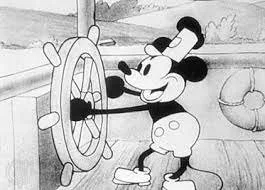It’s the annual Public Domain Day: the day that a bunch of older works enter the public domain. This year, works published in 1928 enter the public domain. There’s no way around it: this year is completely about Mickey Mouse. Steamboat Willie, the first widely available appearance of Mickey Mouse, has fallen into the public domain.
But steer carefully. Only a very specific depiction of Mickey has fallen into the public domain.
This is a significant moment because not long ago Disney spent a lot of lobbying effort and money to avoid it. The Copyright Term Extension Act in 1998 was heavily supported by Disney specifically to avoid Mickey Mouse’s depiction in Steamboat Willie from falling into the public domain. They weren’t the only ones involved, but they were the most prominent proponent of the extension.
Other works have enter the public domain as well, including classic literary works like Lady Chatterley’s Lover and All Quiet on the Western Front. It also includes some of the finest examples of silent film in The Man Who Laughs and The Passion of Joan of Arc.
But one needs to be careful using Mickey Mouse in their own works, as Disney still has newer versions and uses of the character protected. Only the earliest Mickey Mouse of Steamboat Willie fame is in the public domain. Any newer depictions, including his gloves and newer design elements, remain copyrighted. To complicate things, Disney has a trademark on Mickey Mouse, meaning one cannot slap him on merchandise if that leads a consumer into believing the merchandise was made by Disney.
But what one can do is distribute Steamboat Willie and make new art that depicts the characters in that fashion. Just make sure those Steamboat sequels don’t include modern Mickey, and get legal advice before selling specific merchandise.
Happy New Year and Happy Public Domain Day from the Law Firm of Dillon McCarthy!

